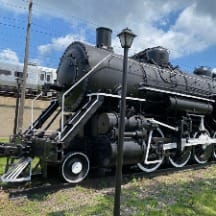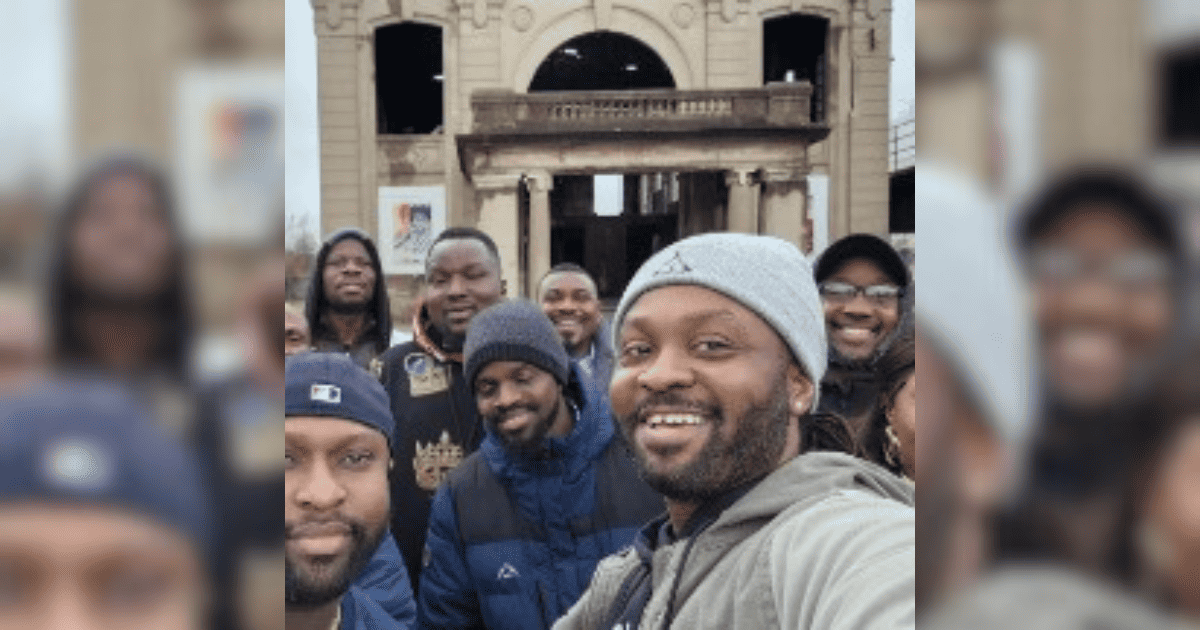TYRELL ANDERSON, front right, head of the Decay Devils, has collaborated with diverse groups to save and repurpose one of Gary’s oldest buildings, Union Station. The station is where the Indiana Dunes National Park begins. Here, he hosts a group from Osun, Nigeria
Part 6 of 10
The stylish Washingtonian magazine identified Studio Theatre’s 1987 move to 14th and P Streets, NW in the nation’s capital as one of the “50 Moments That Shaped Washington, DC.” When founder and former artistic director Joy Zinoman moved the regional theater into an old automotive space in1987, the sidewalks were littered with hypodermic needles and condoms, sex workers prowled the sidewalks, mansions just around the corner wasted away, and there wasn’t even a 7-Eleven.
Today, Studio Theater has expanded, residents and visitors shop on the area’s streets for goods and services from furniture and night clubs to restaurants and fitness centers. The average home price is $823,000, and upscale grocers Whole Foods and Trader Joe’s compete for customers.
In downtown Gary, the Decay Devils are poised to replicate some of that D.C. urban feel at Union Station. “Our overall goal is to save a building and repurpose it,” says Tyrell Anderson, president of the Decay Devils.
The former intercity train station made its film debut in the 1996 film “Original Gangstas,” but the Decay Devils are focusing on transforming the former depot, with its large open-space waiting room, into a mixed-use center. “You have to see the potential for big open space,” advised Zinoman.
This summer the group announced the building will become a fiber optic hub with Digital Equity, LLC as a tenant and a training center with the cooperation of local educational institutions. Earlier, they landed a $125,000 grant from the Indiana Lake Michigan Coastal Program and a $20,000 grant from the 1772 Foundation to create architectural documents for Union Station.
David Graff, a Vice President at Google and one of the many creative volunteers at Decay Devils, was at the groundbreaking. “If you make these investments, business will follow,” says Graff. He added that “I have seen how job opportunities come from similar projects; gives people access.”
The station is at the main gate of United States Steel’s historic Gary Works plant and the eastern gateway to the Indiana Dunes National Park.

Shore and South Bend commuter cars in downtown Gary.
Within walking distance of Union Station, the Decay Devils restored the historic EJ&E No. 765 steam locomotive and is reviving Gateway Park, where the train sits, by turning on its public fountains with a $60,000 grant from Legacy Foundation’s U.S. Steel/City of Gary Indiana Charitable Fund. A John S. and James L. Knight Foundation Donor Advised Fund will also allow the Decay Devils to host several downtown outdoor events.
Knowing that one day the grant money will no longer speed down their tracks, the group is looking for ways to sustain their momentum. One possible route is to become part of a Gary Cultural/Restoration district along with a planned arts center in the 10-story Gary State Bank Building, the city’s tallest building, and the “urban-ruin,” once the prestigious City Methodist Church.
Preservation was not always Anderson’s goal. He started Decay Devils as a photography group that conducted urban explorations to other cities to take pictures. It was during a trip to New Orleans, Louisiana and Savanna, Georgia that he began to change the scope of the group from “taking pictures, to taking action,” he says. It was his witnessing the perseveration of buildings in other locales that aroused his desire to return home to Gary to preserve her past.
First, he approached the school board to allow him to attempt to preserve either Emerson, Horace Mann, or Lew Wallace high school. “The school board shot us down,” he says.
“We then looked at properties where we would probably get the least resistance,” Anderson recalls. They approached the Gary Redevelopment Commission about Union Station and “they jumped right on it,” he added. The Decay Devils wrote a grant for beautification of Union Station for $22,000, “We got it and the preservation efforts began to get a life of its own,” he continued.
Another Garyite, Angele Ledbetter recalls that she met Anderson as an actress looking to be in a film he was producing. She joined him on an urban exploration. She stated that “After seeing other cities preserve their buildings, we said ‘hey, let’s do something for our hometown.’” Ledbetter credits Anderson for having the group turn “their love into a non-profit.”
Will the renovation of Union Station draw and keep people in downtown Gary? The gentrification of 14th Street, NW in Washington, DC in 1987 “was a slow process,” cautioned urban pioneer Zinoman.
Similar to downtown Gary today, she recalls 14th Street, NW having “no restaurants at all, one fish place maybe.” Then, she says, Studio Theater started having “audiences, people were coming at night, then the restaurants came to serve them.” She continued to reflect, “It took a lot of different parts of the community to make it happen, including the press and brave audiences.” Similar to Zinoman’s Studio Theater, the Decay Devils is a nonprofit.
The Studio Theater model has been duplicated in other parts of the nation’s capital. While such cultural investments have proven successful in Washington, the Society for the Restoration of the Gary Aquatorium and Octave Chanute’s Place have proven that citizen led projects can meet success in the Steel City. In Miller, on Gary’s far East Side lakefront, the group has preserved the old Gary Bathhouse, the history of Octave Chanute, and that of the Tuskegee Airmen.
In almost two decades, the Society invested more than two million dollars on the Aquatorium. The former bath house is now available to host banquets, weddings, and small receptions and is an asset to Gary’s crown jewel, Father Pere Jacques Marquette Park – – all of – – which played a part in the selling of the neighborhood’s first one-million-dollar home.
However, downtown Gary has been an oddity, neither the government-built Genesis Convention Center nor the US Steel Yard has been able to attract significant private investments. Unlike the Center and the Yard, Union Station, like Studio Theater, involves private and cultural investors and may just prove to be downtown Gary’s winning show.
Next: Cast Down Your Bucket Where You Are: Renovating IN Gary, IN – Pillar Industries Invest in Gary
Gary. Steel Strong.
Gary native Wayne Young is the publisher of Port of Harlem magazine. Founded by Young in 1995, the magazine is inclusive, diverse, and Pan-African. He is also president of the Port of Harlem Gambian Education Partnership, which funds and manages small projects centering around culture, education, and community in the West African nation. He recently repurposed his parents’ home in Gary into a short-term rental.
Wayne A. Young
Gary native Wayne Young is the publisher of Port of Harlem magazine. Founded by Young in 1995, the magazine is inclusive, diverse, and Pan-African. He is also president of the Port of Harlem Gambian Education Partnership, which funds and manages small projects centering around culture, education, and community in the West African nation. He recently repurposed his parents’ home in Gary into a short-term rental.
-
Wayne A. Young#molongui-disabled-link
-
Wayne A. Young#molongui-disabled-link
-
Wayne A. Young#molongui-disabled-link
-
Wayne A. Young#molongui-disabled-link






